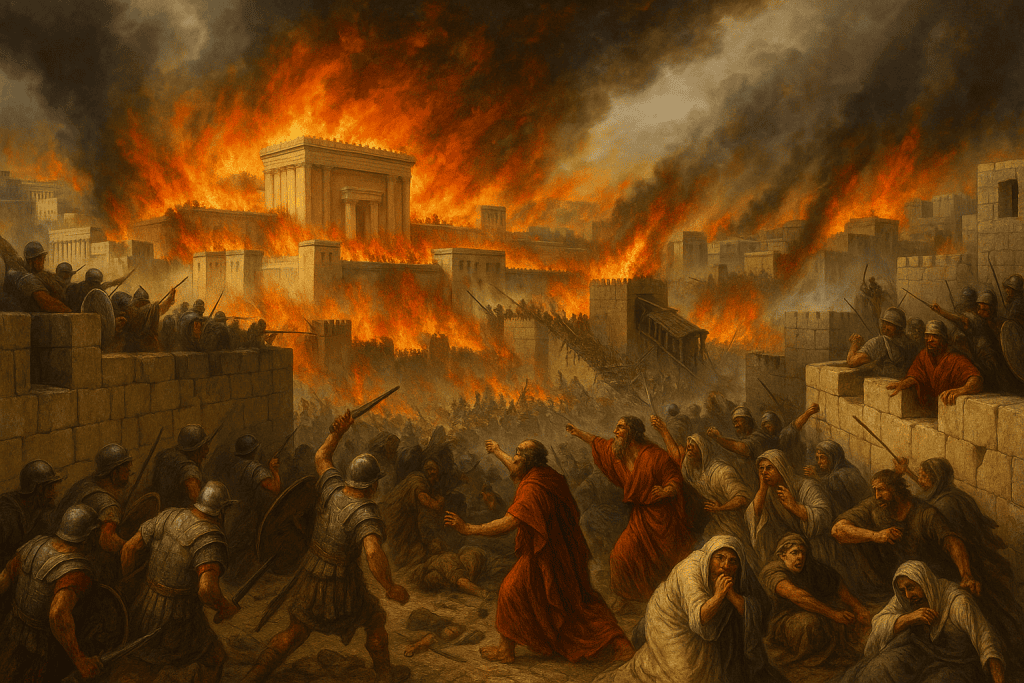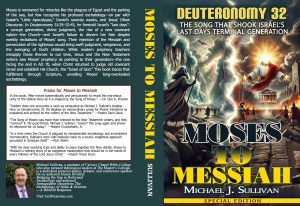Introduction
Daniel 9:24-27 recapitulates and expands the eschatological themes already introduced in Daniel chapters 2 and 7. In Daniel 2 and 7, the Messianic kingdom emerges spiritually from heaven—depicted metaphorically as a stone cut without hands or as the Son of Man descending with the clouds—to judge God’s enemies (stripping dominion from earthly powers) and to grant salvation, authority, and the eternal kingdom to His saints.
But what else occurs at the kingdom’s arrival? Daniel 9:24 reveals more: with the kingdom’s arrival comes forgiveness of sin and the establishment of everlasting righteousness. Just as Daniel 2 and 7 depict salvation for God’s faithful alongside judgment on the hostile nations and apostate Israel (symbolized by the clay in Daniel 2), Daniel 9 elaborates on this judgment. After a prophetic period of 490 years, during the Roman Empire, Daniel predicts that “his people” and “holy city” would face judgment for “cutting off” the Messiah—the same Son of Man introduced in Daniel 7:13 (Dan. 9:26). Consequently, a great war (“the war”) would ensue, and Messiah would send another “prince” at the “appointed time” of the “end” (of Daniel’s 70 weeks) to bring desolation upon Jerusalem and its temple (Dan. 9:26–27, LXX).[1]
Daniel’s final “week” (the last seven-year period) would thus encompass a second-exodus interval of approximately forty years, divided into two critical three-and-a-half-year periods:
- From AD 27-30, culminating with Messiah being “cut off” (crucified);
- From AD 67–70, culminating with Messiah’s judgment through the Romans to desolate the temple and city.
During this terminal generation (cf. Deut. 32:5, 20) Israel would be “filling up” the measure of her sins (Dan. 9:24) while giving time for the gospel to be preached throughout the Roman Empire, saving the remnant and engrafting believing Gentiles into one unified body of Christ—just before the final judgment fell upon the old covenant community.
The Six Events of Daniel 9:24 Fulfilled by AD 70
(1) To Finish Transgression
Daniel 9:24 foretold a time when Jerusalem would “finish” or “fill up” its transgressions against God and His Messiah. Jesus explicitly linked this completion of sin to His contemporary generation, declaring to Israel’s leaders: “Fill up, then, the measure of the sin of your forefathers!” (Matt. 23:32). As Premillennial Zionist Dr. Michael Brown acknowledges (citing James E. Smith):
“To fill up [or restrain] the transgression. Within the 490 years period the people of Israel would commit their final transgression against God. Jesus indicated that the leaders of his generation were about to fill up the measure of the sin of their forefathers (Matt. 23:32)…”[2]
And Dr. Brown himself reinforces this interpretation when he writes:
“…take seriously Yeshua’s words spoken in Matthew 23:32, when he sarcastically exhorted the hostile Jewish leaders of his day, “Fill up the measure of the sin of your forefathers!” Thus, the generation that rejected the Messiah would suffer the culmination of the sins of all the previous generations: “Upon you will come all the righteous blood that has been shed on earth…I tell the truth, all this will come upon this generation” (Matt. 23:35a, 37).”[3]
Unfortunately, Brown’s adherence to premillennial Zionism prevents him from taking seriously Yeshua’s words in Matthew 23, which describe the consummative judgment of the living (e.g., the Pharisees) and the dead (e.g., the martyrs), reaching back to Genesis. As that contemporary generation drew to a close, Revelation confirms this first-century fulfillment: the vindication of the martyrs’ blood at the hands of the great harlot city, Babylon (old covenant Jerusalem, where the Lord was crucified—Rev. 11:8), would occur in a “very little while” at Christ’s “soon” second coming (Rev. 6:10–11; 17–22:6–7, 10–12, 20). This judgment (vindication) and resurrection of the dead align with Jerusalem’s fall in Daniel 12:1–7, during a “three-and-a-half-year” period (AD 67–70) “when the power of the holy people would be shattered” (Dan. 12:7). Peter likewise affirms that this “appointed time for the judgment” of the “living (e.g., Pharisees) and the dead” (e.g., martyrs) was “at hand” (1 Pet. 4:5–7, 17).
(2) Put an End to Sin
In Hebrews, the Saints enter into the Sabbath rest when Christ “put an end to sin” at His imminent, “in a very little while,” Second Appearing as the Great Anointed High Priest. This fulfilled new covenant promises to Israel and closed the “last days” of the old covenant age in AD 70 (Heb. 3-4; 9:26–28; 10:25, 37; Rom. 11:26–27; 13:11–12; Dan. 9:24b).
(3) To Atone for Wickedness or Cover Over Iniquity
This third objective is closely related to the previous point. At Christ’s second appearing, the sins of His people were fully atoned, covered over, and remembered no more in the new covenant creation. Scripture portrays this as God burying their iniquities in the depths of the sea (Isa. 65–66; Mic. 7:19).
(4) To Bring in Everlasting Righteousness
Peter declares that at the AD 70 Day of the Lord, Christ ushered in “everlasting righteousness” or a “world of righteousness,” arriving in an imminent timeframe: “the end of all things is at hand” (1 Pet. 4:5–7; 2 Pet. 3). This was the “inheritance” and “salvation of the soul” ready to be revealed to Peter’s contemporaries (1 Pet. 1:4–12; Acts 2:20–40). Paul similarly taught that this righteousness was “about to be reckoned” for the early Church:
- “But also, on ours, to whom it [righteousness] is about to be reckoned—to us believing on Him who did raise up Jesus our Lord out of the dead” (Rom. 4:24 SLT, LSV, YLT, BLT).
- “For through the Spirit we eagerly await by faith the righteousness for which we hope” (Gal. 5:5).
(5) To Seal Up Vision and Prophet
Many commentators view Daniel 9:24–27 as a concise summary of Jesus’ first and second redemptive comings. Yet they struggle with its conclusion: the destruction of Jerusalem in AD 70, clearly prophesied by Jesus (Luke 21:20–22ff). Jesus is explicit that all Israel’s Old Testament promises and prophetic material regarding His redemptive work—including His second coming—would be fulfilled within the generation of AD 30–70 (Luke 21:22–32).
Old Testament scholars Keil and Delitzsch define the phrase “seal up vision and prophet” aptly:
“Prophecies and prophets are sealed, when by the full realization of all prophecies prophecy ceases, no more prophets any more appear.”[4]
This definition is helpful because it explicitly addresses the cessation of the prophetic office at the completion of Daniel’s seventy weeks. The Hebrew nabiy is used 316 times in the OT, translated as “prophet” 312 times, and only once, in Daniel 9:24, as “prophecy.” This linguistic detail proved pivotal in my public debate with Charismatic Zionist Dr. Michael Brown concerning the cessation of prophecy, tongues, and knowledge by AD 70 (1 Cor. 13:8–12)—a point for which he offered no rebuttal.
Charles John Ellicott echoes this interpretation, connecting the cessation of miraculous signs and revelatory gifts described in 1 Corinthians 13:8–12 with the fulfillment of Daniel 9:24–27:
“The impression of translators being that all visions and prophecies were to receive completed fulfillment in the course of these seventy weeks. It appears…, to be more agreeable to the context to suppose that the prophet is speaking of the absolute cessation of all prophecy” (I Cor. 13:8).[5]
Premillennial Zionist James Leon Wood agrees:
“The words taken together refer to the final fulfillment of revelation and prophecy, i.e., when their functions are shown to be finished.”[6]
(6) To Anoint the Most Holy Place
Christ anointed and consummated the new covenant Church as His Most Holy Place and Bride in AD 70 (cf. Ex. 20, 29–31, 40; Hebrews 9:6–10; Revelation 11:18–19, 19–21:16). David Green insightfully elaborates:
“Finally, it was through the anointing of the Holy Spirit that the whole city of Jerusalem was made new and became “the Tabernacle of God,” when the worldly Holy Place fell in 70 (Heb. 9:1, 8). Under the old covenant, every article of God’s tabernacle was consecrated by the anointing of oil (Ex. 30:25–30; 40:9; Lev. 8:10, 12). In the same way, in the Last Days, God taught His elect ones the truth of His gospel through the anointing of the Holy Spirit (2 Cor. 1:21,22; I Jn. 2:20,27), until all of them had come to know Him (Jn. 6:39). Then came “the end” (Dan. 9:26), when the Body of Christ, all His holy ones, the living and the dead, were raised up to become His anointed (God-taught) “Most Holy Place” in the new covenant world (Jn. 6:44–45; Eph. 2:21–22; Heb. 8:11–13; Rev. 21:3).”[7]
As demonstrated, there is no scriptural justification for inserting a 2,000-year gap between the 69th and 70th seven (week) of Daniel’s prophecy—nor does the prophecy’s fulfillment restart with modern events such as those of 1948. The prophecy, and how the NT develops it, clearly places all the soteriological and eschatological events to be fulfilled when the temple is destroyed in AD 70 and the people judged or rewarded. Since Daniel 2, 7 and 9 all would be fulfilled during the time of the Roman Empire, it becomes clear why Jesus and all of the NT authors emphatically taught that these prophetic events would occur “soon” in their own generation.
The following points summarize key connections between Daniel 7:13–27 and Daniel 9:24–27, highlighting their shared recapitulation:
- The coming of the Son of Man on the clouds (or through another “prince” and his army during the war).
- The appointed time when the saints inherit the kingdom.
- The period of three-and-a-half years of tribulation and desolation.
- The appointed time of judgment, marking the end of the age.
| Daniel 7 – Fulfilled during Roman Empire | Daniel 9 – Fulfilled during Roman Empire |
| (1) “3 ½ years” [AD 67 – AD 70] is the appointed time of consummation (7:25–26) | (1) “3 ½ years” [AD 67 – AD 70] “the war” is the appointed time of consummation (9:26–27) |
| (2) This would be the “appointed time” [the Aramaic cognate to kairos] to the “end” (7:9–10, 22–26) | (2) This would be the “appointed time [Greek LXX kairos] of the end”(9:26–27LXX) |
| (3) Appointed time for the judgment and resurrection of the dead at Christ’s coming upon the clouds when the books are opened (7:9–10) | (3) Implied – consummation of all 6 soteriological / eschatological events at the “appointed time of the end” (9:24–27) |
| (4) The spiritual and eternal kingdom of God in Dan. 2 and 7 comes from heaven to earth and is inherited by the saints (2:34; 7:22, 27) | (4) When the old covenant second temple is destroyed God will build and anoint a spiritual Most Holy Place which came from heaven to earth “soon” in AD 70 (Dan. 9:24; Rev. 21:16—22:7–10, 20) |
| (5) All to be fulfilled during the Roman Empire (7:1–27) | (5) All fulfilled at the end of the 490 years during the Roman Empire(9:24–27) |
Jesus and Daniel 7 = Daniel 9
In Matthew 23–26, Jesus merges Daniel 7 and 9, predicting His cloud-coming within “this generation” (Matt. 23:36; 24:34) to judge and “desolate” Jerusalem and the temple (Matt. 24:2–3ff.; Luke 21:20–32), an event the priesthood would witness (Matt. 26:62–65). Before this judgment, Christians would face intense persecution (Matt. 24:9–10; Dan. 7:21–22). Jews and Romans would commit “abominations” in both the land and temple (Matt. 24:15; Luke 21:20–32), thus “filling up the measure” of Israel’s sins (Matt. 23:29–36), as foretold in Daniel 9:24–27.
The believing remnant and Gentile faithful eagerly awaited Christ’s revelation from heaven, an event that would bring both “kingdom” and “redemption” (Luke 21:27–32; Matt. 24:27–34), as prophesied in Daniel 7:18–27 and 9:24. By blending Daniel 7:13 with Malachi 4:2, Jesus portrays Himself as the “light of day,” shining like the rays of the sun from east to west, or as the “Sun of Righteousness,” healing His people in AD 70 (Matt: 24:27–30, AFV/ANT; Mal: 4:2). This event simultaneously “brought in everlasting righteousness” for believers and consummated judgment on the Second Temple (Dan. 9:24–27; Mal. 3–4; cf. Rom. 4:24, SLT).
Jesus identifies this as the divinely “appointed time” (Greek kairos) and “end” of the old covenant age (Matt. 24:3, 14; Mark 13:32–37; Luke 21:22–24), echoing Daniel 7:22–27 (Aramaic cognate of kairos) and Daniel 9:26–27 (LXX). This period of judgment, coinciding with Jerusalem’s trampling by Gentile forces (“times of the Gentiles”), lasted three and a half years (AD 67–70), exactly matching Daniel’s prophecies (Luke 21:24; Rev. 11:1–8, 18; Dan. 7:22–26; 9:26–27, LXX). Jesus warned the Pharisees and priesthood explicitly that they would personally witness this judgment, including the emergence and subsequent destruction of the arrogant “little horn,” who would speak blasphemies and cause abominations (Dan. 7:8–26; 9:26–27).
Conclusion
Daniel 9:24–27 consolidates and expands the eschatological vision of Daniel 2 and 7, outlining six soteriological and eschatological events—finishing transgression, ending sin, atoning for iniquity, bringing everlasting righteousness, sealing up vision and prophet, and anointing the Most Holy Place—all fulfilled by AD 70 within the Roman Empire. Jesus merges these prophecies with Daniel 7 in Matthew 23–26, explicitly placing their consummation within “this generation” (Matt. 24:34), marked by the judgment of Jerusalem and the temple’s desolation during the “three-and-a-half years” of “the war” (AD 67–70; Dan. 9:26–27). This period saw Israel “fill up” its transgressions (Matt. 23:32), culminating in divine retribution through Roman armies, while the gospel spread, saving the remnant and Gentiles into Christ’s new covenant body (Matt. 24:14). The spiritual Messianic kingdom, depicted as a stone and the Son of Man’s cloud-coming, was fully established, anointing the Church as the Most Holy Place and ushering in everlasting righteousness (Dan. 9:24; Heb. 9:6–10).
By AD 70, the prophetic or miraculous revelatory gifts and office ceased, and all Old Testament promises tied to Christ’s redemptive work were fulfilled, as confirmed by New Testament imminence (Rev. 22:10; 1 Pet. 4:5–7). The “appointed time” (kairos) of Daniel 7:22 and 9:26–27 (LXX) synchronized with Jesus’ teachings, rejecting any 2,000-year gap or futurist reinterpretation. This first-century fulfillment, blending judgment and salvation, reflects God’s covenantal fidelity, transitioning from the old covenant’s end to the new covenant’s maturity. Daniel 9 thus stands as a cornerstone for understanding Christ’s parousia as the “Sun of Righteousness,” bringing redemption and kingdom inheritance to His people while desolating the unfaithful, establishing the Church as the eternal new covenant community in AD 70.
Books by Michael Sullivan: https://fullpreterism.com/product-category/books/

Website: fullpreterism.com
Patreon.com/MikeJSullivan
YouTube teaching videos: @michaelsullivan6868
X: @Preteristesch
[1] Don K. Preston, “Daniel 9, The Seventy Weeks and the LXX,” Full Preterism, February 15, 2016, https://fullpreterism.com/daniel-9-the-seventy-weeks-and-the-lxx-guest-article-by-don-k-preston/.
[2] Michael Brown, AJOJ, Vol. 3, (Grand Rapids, MI: Baker Books, 2003), 93.
[3] Ibid., 96. Emphasis added.
[4] Keil and Delitzsch, Commentary on the Old Testament, Vol. 9, 344.
[5] Charles John Ellicott, Commentary on the Whole Bible, vol. 8 (London: Cassell and Company, 1884), 387.
[6] James Leon Wood, A Commentary on Daniel, (Grand Rapids, MI: Zondervan, 1973), 250.
[7] David A. Green, “From Babylon to Babylon: An Exposition of Daniel’s Seventy Weeks,” Preterist Cosmos, 2003,https://www.preteristcosmos.com/daniel.html.



